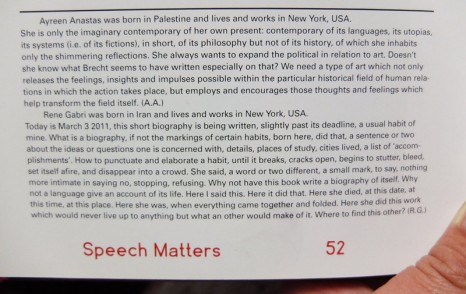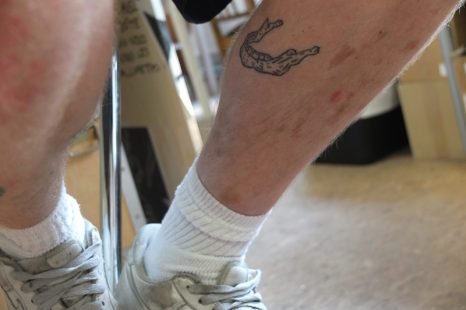 Y’s drawing appeared on his leg a few weeks later…
Y’s drawing appeared on his leg a few weeks later…
Having left out the exact words i had meant to express to her, i sent the e-mail a second time: “oh, before i meant to say: ‘and despite *my fear and nervousness*…’ ” Fear and nervousness to be left out at all costs, if we are to talk about serendipity. Except that it’s a silly word. Except that we couldn’t find the right word in Korean. Because 緣份 is more than serendipity, if we are talking about circles of time, letting things be, how we got here in the first place. I will try to forget about my fear and nervousness, to find comfort in someone else’s words, like D. says—“ç†è«–很舒æœâ€ã€‚
It’s the resonance that she means here, and that is to say a——let’s call it ‘pleasant’——reverberation between the two.
(it’s funny how that’s never really so acceptable in art economies)
 from “Things That are Massively Distributed” by Alma HEIKKILÄ
from “Things That are Massively Distributed” by Alma HEIKKILÄ
Y.Y. and I.S. made an exhibition with the exact same name as our project a few months ago. I didn’t know, I really didn’t know! Clumsily avoided saying too much afterwards except the utterly boring, “I really liked your show”, and basically also delayed to read the accompanying publication, for fear of inadvertently finding too much resonance. But then one thinks they should be doing more research, the spores have already been released and——let’s take small comfort in numbers again——I.S. does write about three plus one becoming understandings of the word ‘catalogue’, so one and one and one and one…new appendages would be the point of these communiqué—let’s grow into our new eachother bodies.
(a question to you though, why does agency become automatically associated in singularities?)
 from “Catalogue Essay” by Isabelle Sully, Catalogue (Publication Studio Rotterdam, 2018)
from “Catalogue Essay” by Isabelle Sully, Catalogue (Publication Studio Rotterdam, 2018)
And then at the cusp of their heat wave, the one that makes a girl conditioned to heat and sweat giggle, other Girls Like Us picked up the same networks of drifting mycellium, and they deconstructed the magazine in another magasin, taking off and piling up, cushions and colours and all forms of care…

from the Girls Like Us workshop; A School, A Park 2018
We keep talking about things that spread and circulate. People, goods, ideas, memes, mycelia. All that fussing about, when actually the question of survival, of making a home (outdated concept?) is a very concentrated, tiny little thing. Like focusing upon words across lines, line to line, and all the networks in the world following through to that little nub at the end of a serif font. And of course it’s no end, Borges, the sentences continue, and your train of thought goes somewhere else. I’ve misunderstood you.

Dear Anna,
Today we had a very nice discussion centring around your book with our collaborators from Read-in and Kunci, and together we came up with a few questions to ask you:

M. has mentioned several times about needing to find out again the name of the Japanese scholar who talked about our Asian spinelessness. In Eastern ontology of print there was no spine. The book was a scroll. Does the spine allude to a ‘Western rigidity’ and an obsession with structure and order? “We have no spine but that will be something that we’ll talk about.”
(but to have the courage to talk about it, i’ll have to forget my fear and nervousness)
To mention in speech what somebody else has said is perhaps a way of ‘owning it’. Or what are the footnotes of speech? Can the simultaneity of attributions be translated in real-time, like ASMR tingles and little cartoon devils on shoulders? And what if you are the one who is really terrible at telling stories, at making the punchline of the joke work? No, I think I’m funnier in Chinese.
But what I really wanted to tell you about is something that has half-slipped my memory for at least ten years now, though the other half of it keeps coming up every now and again, like those waves of text while walking.
I read you here and I read you there, here and there, like a spore trapped in my memory because I will always remember the fuzz of something in the vicinity of you on the page. At the same time I know exactly where you are, left or right, a third of the way down…everything else in darkness as we rode a night bus through a foreign country.
— from the COVER; Hong Kong, Shenzhen and Guangzhou, Display Distribute『CATALOGUEã€No. 3, co-edited with Kunci and Read-in
This one was somewhere about three-quarters of the way down, on some days it’s on the left side of the page, on others it’s the right. He talks about the linguistic typology of words that become true by virtue of their utterance——what are they called? In conjunction with this writing, I tried——as I do every once in a while when I want to ‘own it’, to track it down again. Weird keyword searches, scanning the possible PDFs. Tonight I realised that I must have lost the hard copy of that beloved book, the one that I think it’s in. But then I found only one sentence from the entire PDF version highlighted: “For human beings who have lost every sense of naturalness, each single gesture becomes a destiny.”
I won’t tell you who this comes from so that you’ll feel the same haziness as I do,
(remember my place on the page)
as if I was telling it to you in casual conversation while we are waiting together for something. Let’s own it. But anyway, it’s not the term ‘speech acts’. Though I saw that exhibition as well. If we should talk about our being-in-language, utterances to representation, yes, then my fear and nervousness comes back, a whole life gone by…destiny. and it circles back to 緣份. it must be circular, it must be circular, I say to myself. Not so grandiose as a speech act, but as small and tiny a little thing, like, “sigh…”
____________
* This post is also, in ever so slight variation, germinating another website called åœç¾¤ Monument of Apron。
Posted by 丫 | reply »biography Posted by 丫 | reply »
on iwishicoulddescribeittoyoubetter, eyh
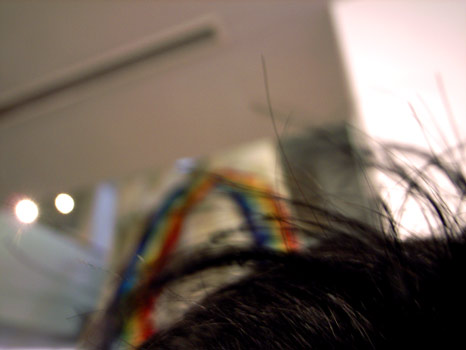 Who made this? asks the naive moment.
Who made this? asks the naive moment.
My first stir of thought has been to think of making.
The idea of making is the first and most human of ideas.
“To explain” is never anything more than to describe a way of making: it is merely to remake in thought.
—- from Paul Valéry, “Man and Sea Shell,” in The Collected Works of Paul Valéry, vol. 1 (Princeton: Princeton University Press, 1956), p. 117.
Posted by 丫 | reply »installation, the morning after
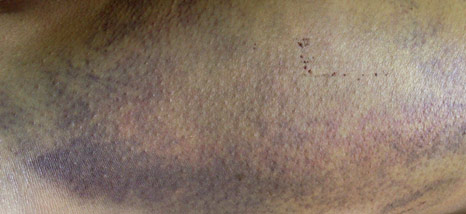
![]()
As creators, we can say that there is an audience for our work, whereby “public” is both an excuse and a reason. And yet as creators within a social sphere, our unabashed ability to colonialise spaces, and even publics, actually distances us from any notion of real interaction rather than that of working context-specific, conscientiously and in cohesion with those collaborating with us.![]() In the example of the bi/tri-ennial, the clearest cut form of discourse seems to lie not within the vocabulary of the host city, not within the realm of “the work” and at times hardly even within the actual processes of production. As recently overheard from an independent curator about the opening night party of the 2007 Shenzhen-Hong Kong Biennale of Architecture and Urbanism, “Well, that’s what we came for.”
In the example of the bi/tri-ennial, the clearest cut form of discourse seems to lie not within the vocabulary of the host city, not within the realm of “the work” and at times hardly even within the actual processes of production. As recently overheard from an independent curator about the opening night party of the 2007 Shenzhen-Hong Kong Biennale of Architecture and Urbanism, “Well, that’s what we came for.”![]() Chief curator of the Biennale Ma Qingyun is at a loss. “But we worked so hard…”
Chief curator of the Biennale Ma Qingyun is at a loss. “But we worked so hard…”![]() The bi/tri-ennial are event-based phenomenona, as new technology, “our latest project”, and another friday night scene. Critical exchange, then, takes a cue, as a breather after all that hard work—-at bars, the after-parties and nestled within the snide comments made during other people’s speeches. It is hard to understand what sort of feedback and interaction one can stimulate or expect from an event involving a mass public audience. “I hope they’ll collect the press clippings,” says one architect in the back of the taxi, on the way to a bar after the after-party. And yes, these traditional forms of review may still be helpful and necessary within a larger system of creative production. But the formality of a critic’s theoretical opinion or a blogger’s on-the-scene action shots bely the stagnancy of the actuality. The sponsor hotel where most exhibitors stay always makes for a much more active and dynamic space than that last exhibition hall.
The bi/tri-ennial are event-based phenomenona, as new technology, “our latest project”, and another friday night scene. Critical exchange, then, takes a cue, as a breather after all that hard work—-at bars, the after-parties and nestled within the snide comments made during other people’s speeches. It is hard to understand what sort of feedback and interaction one can stimulate or expect from an event involving a mass public audience. “I hope they’ll collect the press clippings,” says one architect in the back of the taxi, on the way to a bar after the after-party. And yes, these traditional forms of review may still be helpful and necessary within a larger system of creative production. But the formality of a critic’s theoretical opinion or a blogger’s on-the-scene action shots bely the stagnancy of the actuality. The sponsor hotel where most exhibitors stay always makes for a much more active and dynamic space than that last exhibition hall.![]() Where are the relationships between work, audience and creator within the framework of the art event? Are we merely using ideas as a way of colonialising the spectacle space? Working carries over into presentation carries over into documentation carries over into publicisation. And where again is the space for the work? Somewhere between making contacts and trying to catch hold of the installation team to get the right equipment.
Where are the relationships between work, audience and creator within the framework of the art event? Are we merely using ideas as a way of colonialising the spectacle space? Working carries over into presentation carries over into documentation carries over into publicisation. And where again is the space for the work? Somewhere between making contacts and trying to catch hold of the installation team to get the right equipment.
![]() This is not meant to bemoan the poor artist who tries to be simultaneously active in all of these areas of art production. Nor can we blame the event structure alone. But is it naïve to still long for project-based work that does not neglect the need for post-planning, responsibility and respect for the other?
This is not meant to bemoan the poor artist who tries to be simultaneously active in all of these areas of art production. Nor can we blame the event structure alone. But is it naïve to still long for project-based work that does not neglect the need for post-planning, responsibility and respect for the other?![]() Would it be possible to leave an event of this kind without a feeling of the morning-after?
Would it be possible to leave an event of this kind without a feeling of the morning-after?
how i spent my time at the Venice Biennale, or, looking for mere life.
The crux of this situation is one of returning to an academic reportage—after the holiday, after the event, after stepping out of the heretofore all-encompassing realm that is the Home and learning to tell or recount (and what not) to our classmates, our teachers, our friends. Spending the entire summer hanging out by the pool and eating sandwiches with the crusts cut off may have been real life. But how much of a real life do we access, relive, or reveal when writing about our experiences, passing them on to others, or trying to capture them via other media simultaneous to the experience (i.e., photographs, audio recording, drawing, etc.)? If we make art from/of our lives are the results still a reflection of the world we live in, and how much do we really reveal about ourselves through the process? More? Less? Is life as recorded in a journal, a newspaper, an uploaded video or a painting symmetrical to “mere life� Or parallel?
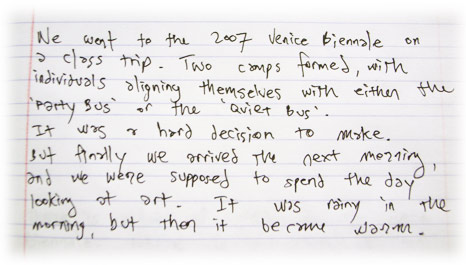 The question of life in art is not at least in part a question of reality and document, of truth and artifact. Insofar that life is being, it is the living element of a work of art, its energeia, which we recognise, or recognises us, is capable of moving us beyond our own mere lives towards truth and Heidegger’s sense of the world worlded, “more fully in being than the tangible and perceptible realm in which we believe ourselves to be at home.†To find, then, the evocation of life in the artwork does not set up a dichotomy as implied by the analogy of reality to document, truth to artifact. We can look perhaps more towards Adorno’s dialectics, not by way of simple polarities but a dialecticalism whereby one is contained in the other—art and life mutually inherent.
The question of life in art is not at least in part a question of reality and document, of truth and artifact. Insofar that life is being, it is the living element of a work of art, its energeia, which we recognise, or recognises us, is capable of moving us beyond our own mere lives towards truth and Heidegger’s sense of the world worlded, “more fully in being than the tangible and perceptible realm in which we believe ourselves to be at home.†To find, then, the evocation of life in the artwork does not set up a dichotomy as implied by the analogy of reality to document, truth to artifact. We can look perhaps more towards Adorno’s dialectics, not by way of simple polarities but a dialecticalism whereby one is contained in the other—art and life mutually inherent.![]() Even so, the “mere life†evoked in a work of art is by no means equal to reality. The distance between the two can be described as a greater truth or a place of the spirit, but perhaps, much less glamourously—not so far off from the gap between seeing someone’s endless vacation slideshow versus having been part of the real experience. One approaches a higher plane of being, the other is, very often, just a bore.
Even so, the “mere life†evoked in a work of art is by no means equal to reality. The distance between the two can be described as a greater truth or a place of the spirit, but perhaps, much less glamourously—not so far off from the gap between seeing someone’s endless vacation slideshow versus having been part of the real experience. One approaches a higher plane of being, the other is, very often, just a bore.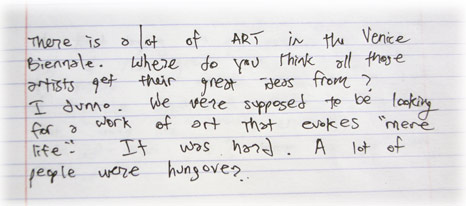 At the Biennale di Venezia, a near Disneyland of contemporary art and national identity, we are afforded the small world after all of contemporary art multiculturalism. The short examples following interest me here as different national perceptions positioning life relative to art. The stereotypes that emerge are perhaps an ironically self-conscious colouring of the ways the simulacra overtakes us even in self-presentation, but at the current stage of hyper visual culture, it is possible in this context to raise new questions regarding art as presentation (show, artifact, material, object) versus documentation (alternate reality, report, medium, subject).
At the Biennale di Venezia, a near Disneyland of contemporary art and national identity, we are afforded the small world after all of contemporary art multiculturalism. The short examples following interest me here as different national perceptions positioning life relative to art. The stereotypes that emerge are perhaps an ironically self-conscious colouring of the ways the simulacra overtakes us even in self-presentation, but at the current stage of hyper visual culture, it is possible in this context to raise new questions regarding art as presentation (show, artifact, material, object) versus documentation (alternate reality, report, medium, subject).![]() Japan, History and Tradition.The most physically direct form of document was created by artist Masao Okabe for the Japan pavilion. His work consisted of a series of 1,400 frottages made with pencil on paper, rubbed directly on the surface of stones that made up the World War II bombed platforms of the former Ujina train station in Hiroshima. Okabe’s work is a document of history, a literal tracing of stone as the ultimate testament to the fragilities wrought by war, where even rock is impermanent, its solidity transferred into the grainy shades produces by a sketch, no more certain than the dead flowers and leaves pressed under glass throughout the installation. His is a document of “mere life†in its most physical approach, but its results question the viability of history via transference across artifact, time and medium.
Japan, History and Tradition.The most physically direct form of document was created by artist Masao Okabe for the Japan pavilion. His work consisted of a series of 1,400 frottages made with pencil on paper, rubbed directly on the surface of stones that made up the World War II bombed platforms of the former Ujina train station in Hiroshima. Okabe’s work is a document of history, a literal tracing of stone as the ultimate testament to the fragilities wrought by war, where even rock is impermanent, its solidity transferred into the grainy shades produces by a sketch, no more certain than the dead flowers and leaves pressed under glass throughout the installation. His is a document of “mere life†in its most physical approach, but its results question the viability of history via transference across artifact, time and medium.![]() France, Love.Sophie Calle’s work can also be said to be evocative of “mere life†in the sense that it is largely autobiographical, and the source of her piece for the French pavilion is no exception, although this time Calle succeeds in moving her story outside of her own life and recapturing it through others— 107 other women, precisely. By asking each of the participants to translate, interpret or explain a break-up letter received from her lover, Calle is able to create a prism of images of the lives and perspectives of these women, revoiced in the form of dance numbers, linguistic corrections and psychological diagnoses among others. Insodoing, the acuteness of a supposedly ‘real’ emotional situation becomes estranged, dramatised and made multiplicitous. “Mere life†is simply a matter of perspective.
France, Love.Sophie Calle’s work can also be said to be evocative of “mere life†in the sense that it is largely autobiographical, and the source of her piece for the French pavilion is no exception, although this time Calle succeeds in moving her story outside of her own life and recapturing it through others— 107 other women, precisely. By asking each of the participants to translate, interpret or explain a break-up letter received from her lover, Calle is able to create a prism of images of the lives and perspectives of these women, revoiced in the form of dance numbers, linguistic corrections and psychological diagnoses among others. Insodoing, the acuteness of a supposedly ‘real’ emotional situation becomes estranged, dramatised and made multiplicitous. “Mere life†is simply a matter of perspective.![]() China, Future. Cao Fei’s use of the internet portal Second Life to create her video installation for the Chinese pavilion brings ‘reality’ directly into the art world, as it investigates a phenomenon that is transpiring in the immediate present, being translated across media from a virtuality through the internet to a mass phenomenon, not necessarily in terms of users but certainly by press coverage. The irony and fascination that Second Life poses for both Cao and the media is that the form of reality proposed by it is one that projects itself as a future for everyone, and the ambivalent possibilities proffered by this future are ones that reacts back upon the present of our “mere†everyday realities. Her documentary made entirely from footage of the voyages of her Second Life avatar, China Tracy, turn the strangely connected but utterly desolate world before us into a montage of cinematic moments, like nostalgic flashbacks of something not yet experienced.
China, Future. Cao Fei’s use of the internet portal Second Life to create her video installation for the Chinese pavilion brings ‘reality’ directly into the art world, as it investigates a phenomenon that is transpiring in the immediate present, being translated across media from a virtuality through the internet to a mass phenomenon, not necessarily in terms of users but certainly by press coverage. The irony and fascination that Second Life poses for both Cao and the media is that the form of reality proposed by it is one that projects itself as a future for everyone, and the ambivalent possibilities proffered by this future are ones that reacts back upon the present of our “mere†everyday realities. Her documentary made entirely from footage of the voyages of her Second Life avatar, China Tracy, turn the strangely connected but utterly desolate world before us into a montage of cinematic moments, like nostalgic flashbacks of something not yet experienced.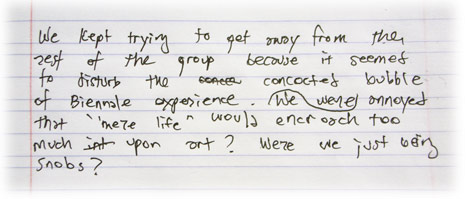 Why am I writing this again?
Why am I writing this again?![]() Oh yes, Biennale experience. Mere life.
Oh yes, Biennale experience. Mere life.![]() Is it a coincidence that this question of mere life is actually one of the primary themes of this year’s Documenta exhibition? Perhaps we should look outside of the context of a self-inflated art exhibition towards another, slightly-less-self-inflated-but-on-the-Grand-Tour-nonetheless art exhibition to get back to this question of mere life.
Is it a coincidence that this question of mere life is actually one of the primary themes of this year’s Documenta exhibition? Perhaps we should look outside of the context of a self-inflated art exhibition towards another, slightly-less-self-inflated-but-on-the-Grand-Tour-nonetheless art exhibition to get back to this question of mere life.![]() Or, perhaps mere life is merely in the looking.
Or, perhaps mere life is merely in the looking.![]() I’ll let you know after we get to Kassel.
I’ll let you know after we get to Kassel.

